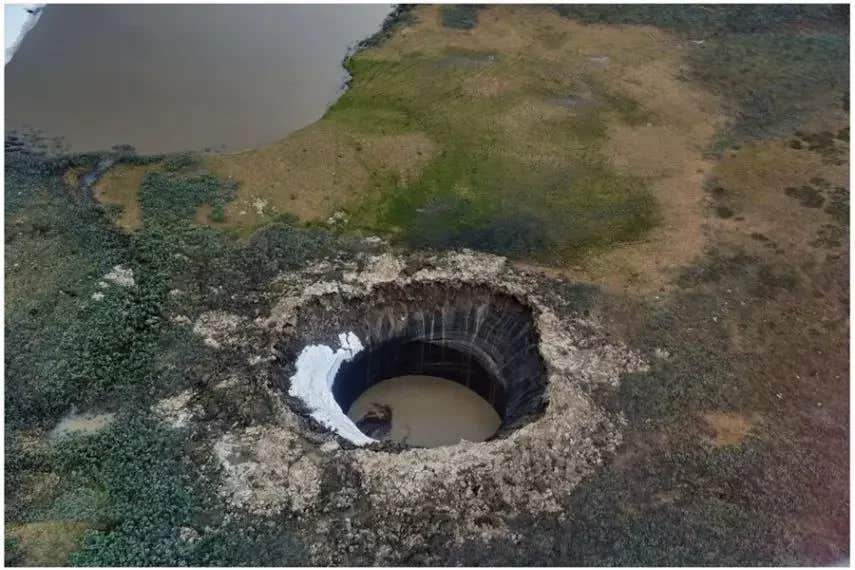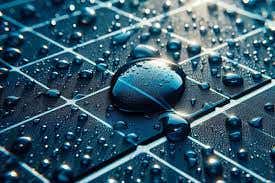Researchers discover why explosive craters are suddenly appearing in Siberia
Mysterious explosive craters have emerged in Siberia’s Yamal Peninsula over the past decade, perplexing scientists.

The Yamal crater [ru] — Top: 2015, bottom: heaving mound and the crater formed after the explosion. (CREDIT: Wikimedia / CC BY-SA 4.0)
Mysterious craters have emerged in Siberia’s Yamal Peninsula over the past decade, perplexing scientists. These craters, first observed in 2014, appear due to explosive methane release, triggered by climate change and specific geological factors.
The phenomenon underscores the interplay between Earth’s warming surface and the unique underground landscape of northern Siberia, where trapped gases are now erupting with forceful and potentially significant environmental impacts.
The craters, now appearing on both Yamal and the adjacent Gydan Peninsula, reveal a unique geophysical process: as Arctic temperatures rise, methane hydrates, which are stable under cold, high-pressure conditions, decompose, setting off explosive reactions.
These methane hydrates—crystallized compounds of methane and water—exist in permafrost layers due to the region's exceptionally low temperatures and high pressure. However, the warming climate is altering this stability, resulting in the dramatic explosions that create the craters.
Researchers from the University of Cambridge and the Spanish National Research Council have collaborated to unravel the mystery behind these craters. "There are very, very specific conditions that allow for this phenomenon to happen," explains Ana Morgado, a chemical engineer at the University of Cambridge. The craters, which release substantial amounts of methane, a powerful greenhouse gas, could have significant impacts on climate if they continue to increase in frequency.
Investigating the Explosions
The research team began by analyzing the nature of the explosions. Julyan Cartwright, a geophysicist at the Spanish National Research Council, describes the process simply: "There are only two ways you can get an explosion: a chemical reaction or a physical buildup of pressure."
With no signs of combustion in these Siberian events, the team ruled out a chemical reaction, concluding the explosions had a physical cause. The culprit, they determined, was an increase in underground pressure caused by osmosis.
Related Stories
In essence, osmosis refers to the movement of water across a barrier to equalize substance concentrations on either side. In Yamal’s case, salty water trapped in underground pockets called cryopegs acts as an osmotic barrier within the thick permafrost. Normally, these cryopegs remain stable, sandwiched between the permafrost above and methane hydrates below.
How Warming Causes Methane to Explode
The Yamal Peninsula’s permafrost layer, a massive sheet of frozen earth extending up to 300 meters deep, is capped by an active layer that thaws and refreezes with the seasons. Under typical Arctic conditions, this active layer remains shallow, but climate change is driving it deeper into the permafrost. As the active layer melts, it releases water that moves downward, pulled into the salty cryopegs through osmotic pressure.
But the cryopegs have limited space, and the influx of meltwater from the active layer creates excessive pressure, forming cracks in the overlying permafrost. Once the cracks reach the surface, pressure in the cryopeg plummets, destabilizing the methane hydrates below. This shift triggers an explosive release of methane gas, which propels soil and rocks upwards, forming the characteristic craters.
This process of destabilization and explosion, accelerated by Arctic warming, can occur within decades rather than over millennia as previously assumed. This relatively rapid timeline aligns with global temperature trends since the 1980s, which have impacted Arctic ecosystems faster than most other regions.
Climate Change and the Expanding Crater Field
Although the appearance of craters like these is rare, the potential for more frequent explosions exists as temperatures in the Arctic continue to climb. Researchers note that the northern regions are warming twice as fast as other parts of the globe, creating a feedback loop that could intensify as more methane is released into the atmosphere. Methane, with its potent greenhouse effect, can exacerbate climate warming further, fueling the conditions that cause such explosions in the first place.
The discovery of this cycle underscores the vulnerability of methane hydrates in permafrost zones worldwide. Many estimates suggest that methane hydrates constitute one of the largest untapped sources of hydrocarbons on Earth. For Siberian regions like Yamal, warming trends may not only trigger explosive reactions but also add greenhouse gases to the atmosphere, accelerating the changes that threaten permafrost stability.
Implications for the Future
The explosive methane craters in Siberia serve as a stark reminder of how climate change can lead to unpredictable consequences. The Yamal Peninsula’s geology, with its thick, porous clay soil and unfrozen water layers, has made it uniquely susceptible to these explosive events. "This might be a very infrequently occurring phenomenon," Morgado explains, "but the amount of methane that’s being released could have quite a big impact on global warming."
The scientific community continues to investigate the Yamal Peninsula’s craters, looking to understand the exact mechanisms driving these explosions and determine whether similar conditions could emerge in other permafrost regions.
The presence of cryopegs and methane hydrates in permafrost layers across the Arctic suggests that this phenomenon might not be limited to Siberia. With temperatures rising and more permafrost regions melting, the release of methane could potentially become a broader environmental hazard.
This recent study, published in the journal Geophysical Research Letters, highlights the critical role of permafrost in maintaining Earth’s climate balance. As permafrost continues to thaw, more attention will likely be directed toward understanding how these subsurface layers interact with climate and what additional surprises may await as warming progresses.
The Yamal crater explosions are more than just geological curiosities—they are potential signals of broader environmental changes that may soon impact more than just Siberia’s frozen soils.
For now, scientists are working to decode this powerful interplay of osmosis, geology, and climate change, but the explosive craters already stand as visible and urgent reminders of what’s at stake.
Note: Materials provided above by The Brighter Side of News. Content may be edited for style and length.
Like these kind of feel good stories? Get The Brighter Side of News' newsletter.
Joshua Shavit
Science & Technology Writer | AI and Robotics Reporter
Joshua Shavit is a Los Angeles-based science and technology writer with a passion for exploring the breakthroughs shaping the future. As a contributor to The Brighter Side of News, he focuses on positive and transformative advancements in AI, technology, physics, engineering, robotics and space science. Joshua is currently working towards a Bachelor of Science in Business Administration at the University of California, Berkeley. He combines his academic background with a talent for storytelling, making complex scientific discoveries engaging and accessible. His work highlights the innovators behind the ideas, bringing readers closer to the people driving progress.



